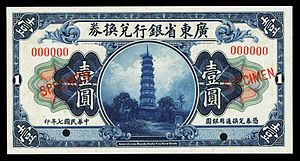| This article needs additional citations for verification. Please help improve this article by adding citations to reliable sources. Unsourced material may be challenged and removed. Find sources: "Temple of the Six Banyan Trees" – news · newspapers · books · scholar · JSTOR (July 2023) (Learn how and when to remove this message) |
| Temple of the Six Banyan Trees 六榕寺 | |
|---|---|
 The Temple's pagoda The Temple's pagoda | |
| Religion | |
| Affiliation | Buddhism |
| Location | |
| Location | Guangzhou, Guangdong |
| Country | People's Republic of China |
| Geographic coordinates | 23°07′41″N 113°15′38″E / 23.128185°N 113.260642°E / 23.128185; 113.260642 |
| Architecture | |
| Completed | 537 AD |
| Temple of the Six Banyan Trees | |||||||||||||||
|---|---|---|---|---|---|---|---|---|---|---|---|---|---|---|---|
| Chinese | 六榕寺 | ||||||||||||||
| |||||||||||||||




The Temple of the Six Banyan Trees or Liurong Temple is a Buddhist temple in Guangzhou, China, originally built in AD 537.
The temple's proximity to foreign consulates in Guangzhou has made it a regular destination for families participating in the international adoption of children from China. Typically families receive blessings for their newly adopted children at this temple in front of the statue of Guanyin.
History
The Baozhuangyan Temple was first constructed by the monk Tanyu under orders from Emperor Wu of the Liang in AD 537. It was constructed to house the relics of Cambodian Buddhist saints which had been brought to Panyu (modern Guangzhou).
The temple was burned down and rebuilt during the Northern Song dynasty. Around the same time, Su Shi composed a poem "Six Banyans" (Liu Rong) in honor of a visit to the temple. It was since renamed in honor of the famous poem.
The Flower Pagoda, the main structure of the temple, was built in 1097 and was named for its colorful exterior. The structure that had been there before had a square base, but the Flower Pagoda was designed with an octagonal one. It was rebuilt again in 1373 after another fire in the early Ming dynasty period and restored in 1900.
See also
- Chinese Buddhism
- List of Buddhist temples
- Guangxiao Temple (Guangzhou)
- Hualin Temple (Guangzhou)
- Ocean Banner Temple
References
- Jocelyn, H.D. (1971). "Donatvs Ad Ter. Ad. 537". Mnemosyne. 24 (1): 90–91. doi:10.1163/156852571x00488. ISSN 0026-7074.
- Zheng, Haiyao; Mo, Tao; Gong, Huicheng; Zhang, Haoliang (2023-03-28). "Retrospective Analysis of Postoperative Effect of Supratubal Recess Opened and Bony Obliteration Tympanoplasty". The Journal of International Advanced Otology. 19 (2): 105–111. doi:10.5152/iao.2023.22758. PMC 10152080.
- "Institutionalizing International Adoption: The Historical Origins of Korean Adoption in the United States", International Korean Adoption, Routledge, pp. 49–66, 2013-02-01, ISBN 978-0-203-05145-0, retrieved 2023-07-10
- "Guanyin". Religion in Geschichte und Gegenwart. Retrieved 2023-07-10.
External links
| Yuexiu District | |||||||
|---|---|---|---|---|---|---|---|
| Subdistricts | |||||||
| Landmarks | |||||||
| Geography | |||||||
| Transport |
| ||||||
| Education |
| ||||||
| This list is incomplete. École Française Internationale de Canton was previously on Ersha Island | |||||||
| Buddhist temples in China | |||||||||
|---|---|---|---|---|---|---|---|---|---|
| |||||||||
| |||||||||
| |||||||||
| Guangzhou | ||
|---|---|---|
| Administrative divisions |    | |
| Attractions |
| |
| Culture & demographics | ||
| Higher Education |
| |
| History | ||
| Sports venues |
| |
| Transport | ||
- National Key Buddhist Temples in Han Chinese Area
- 537 establishments
- 6th-century establishments in China
- Buildings and structures completed in 1097
- Religious buildings and structures completed in the 1090s
- 11th-century Buddhist temples
- Buildings and structures completed in 1373
- Religious buildings and structures completed in the 1370s
- 14th-century Buddhist temples
- Buddhist temples in Guangzhou
- Yuexiu District
- Pagodas in China
- Ming dynasty architecture
- 6th-century Buddhist temples
- Major National Historical and Cultural Sites in Guangdong